I was part of the Nanode Dev team. The main inventor of the Nanode Hardware was Ken Boak. Nanode is an open source Arduino-like board that has in-built web connectivity. It is a low cost platform for creative development of web connected ideas. Languages: C
In Ken's words: "When I designed the hardware for Nanode, I worked to a very tight budget. It had to appeal to college students, amateurs and hackers.
Working in association with the London Hackspace I fixed the price (for members) at £18 ($30) and we initially built a batch of 100 units. We ran a couple of weekend workshops and built them up from kits. Shipping costs were not included – and we have seen a rise in some of the IC prices since then.
That was in early June. Since then we have produced a total of 550 pcbs so far – and shipped 450 of them.
Nanode is now available in the US, exclusively from http://wickeddevice.com in upstate New York.
Wicked Device will soon be making their own run of pcbs ready on the market in time for the NYC Maker Faire.
From the start, Nanode had to be simple and straightforward to build – with conventional through hole components and socketed ICs. Following our pictorial assembly guide, I have seen dozens of Nanodes built by beginners – often their first real soldering project.
We are not trying to compete in any way with 32bit ARM devices – but we wanted a board that worked like an Arduino with a few extra features, such as ethernet connectivity and easy wireless and wired networking.
Nanode is intended as a starter kit for web connected devices such as remote control, home automation and smart sensors. Later on there will be other variants, with built in wireless and available as a very compact SMT module.
Nanode does not yet offer PoE, and you will need a FTDI or similar USB to serial adaptor cable to program it. In that respect it is similar to the standard version of the Ethernet Arduino – but a fraction of the price.
Nanode is looking for resellers in Europe and Asia. If you want to get involved either commercially or join in with collaborative development, please contact me via @Monsonite on Twitter.
Ken"
Nanode
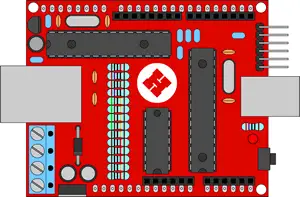
Project Details
The Nanode project, launched at London hackspace, is an open source Arduino-like board with built-in web connectivity (IoT). It can connect to various wireless, wired, and ethernet interfaces, allowing for the development of web-based sensor and control systems. It provides web access to six analogue sensor lines and six digital I/O lines, making it ideal for hacking projects. The Nanode is affordable, costing under £20 as an easy-to-build kit. It has gained popularity and has been replicated in hackerspaces and workshops across Europe. Additionally, it has been featured on Hackaday, a popular online platform for DIY electronics projects.
What is Nanode?
Nanode is a Network Application Node - a small, low cost, web-connected controller, intended to be at the frontline of the Internet of Things. (IoT).
Nanode is a combination of low cost microcontroller and ethernet controller assembled on the same small pcb. This makes the simplest, cheapest solution to get connected to the internet - half the cost of an Arduino and Ethernet Shield!
It uses the same micro as used in the popular Arduino project - the ATmega328, which with some extra memory and a web connection can make a powerful control and monitoring device - but small enough and cheap enough to be built into many products and be the starting point for developing ideas.
Nanode has good compatibility with Arduino - accepting most Arduino shields, and can programmed using Arduino IDE.
As well as ethernet connectivity we have added serial interface (with FTDI cable), Virtual USB, a local serial slave bus and a connector to take a low cost wireless module.
Nanode also accepts a low cost SPI memory such as SRAM, FRAM, Flash or SDCard to allow larger program and data storage for datalogging.
Nanode was originated at the London Hackspace and used by OpenEnergyMonitor as part of their web connected energy monitoring system.
Nanode is a combination of low cost microcontroller and ethernet controller assembled on the same small pcb. This makes the simplest, cheapest solution to get connected to the internet - half the cost of an Arduino and Ethernet Shield!
It uses the same micro as used in the popular Arduino project - the ATmega328, which with some extra memory and a web connection can make a powerful control and monitoring device - but small enough and cheap enough to be built into many products and be the starting point for developing ideas.
Nanode has good compatibility with Arduino - accepting most Arduino shields, and can programmed using Arduino IDE.
As well as ethernet connectivity we have added serial interface (with FTDI cable), Virtual USB, a local serial slave bus and a connector to take a low cost wireless module.
Nanode also accepts a low cost SPI memory such as SRAM, FRAM, Flash or SDCard to allow larger program and data storage for datalogging.
Nanode was originated at the London Hackspace and used by OpenEnergyMonitor as part of their web connected energy monitoring system.
Technical Specifications
-16MHz ATmega328 microcontroller.
-10BASE-T Ethernet controller ENC28J60.
-Unique MAC address generator.
-Simple Web connection using DHCP.
-SPI expansion memory (SRAM, Flash or FRAM).
-Compatible with JeeLabs RFM12B wireless board.
-6 analogue sensor lines with 10 bit A-D converter.
-Up to 14 digital I/O lines.
-Can drive servos, displays etc.
-Serial Inter-Nanode Bus - allows Nanodes to be slaved together.
-atmega328P core running at 16MHz.
-32KB ISP flash memory.
-1KB EEPROM.
-2KB SRAM.
-5V 250mA - USB or external Power
-10BASE-T Ethernet controller ENC28J60.
-Unique MAC address generator.
-Simple Web connection using DHCP.
-SPI expansion memory (SRAM, Flash or FRAM).
-Compatible with JeeLabs RFM12B wireless board.
-6 analogue sensor lines with 10 bit A-D converter.
-Up to 14 digital I/O lines.
-Can drive servos, displays etc.
-Serial Inter-Nanode Bus - allows Nanodes to be slaved together.
-atmega328P core running at 16MHz.
-32KB ISP flash memory.
-1KB EEPROM.
-2KB SRAM.
-5V 250mA - USB or external Power
Image Gallery
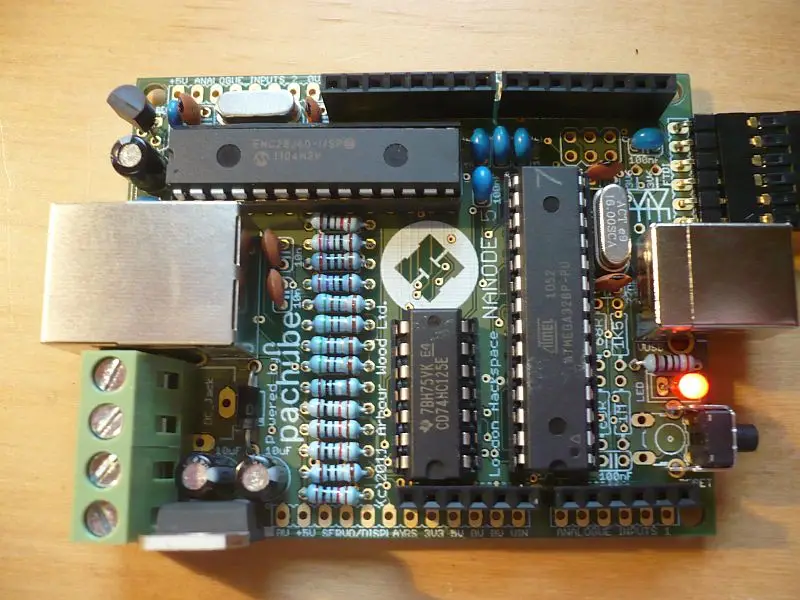 A fully populated nanode board running arduino blink sketch. It lives!
A fully populated nanode board running arduino blink sketch. It lives!
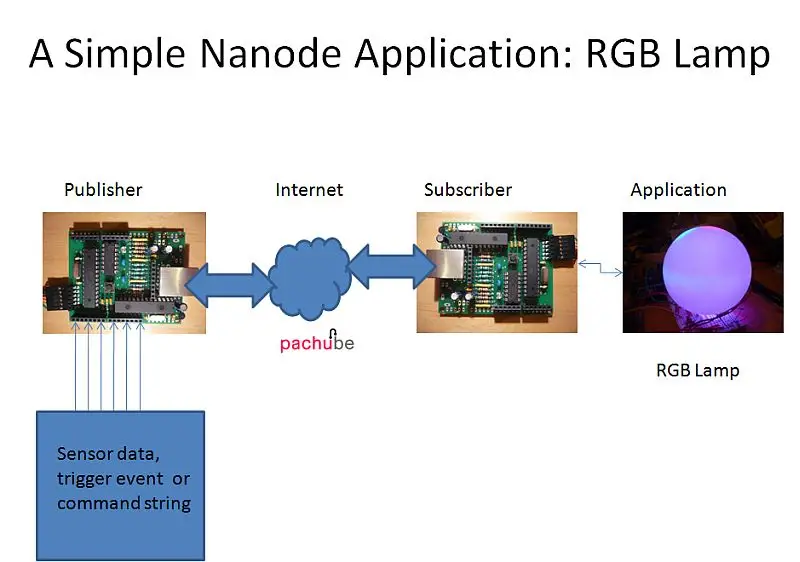 An example of running Nanode with the Pachube pub/sub service storing sensor readings and actuating an RGB LED / physical notifier.
An example of running Nanode with the Pachube pub/sub service storing sensor readings and actuating an RGB LED / physical notifier.
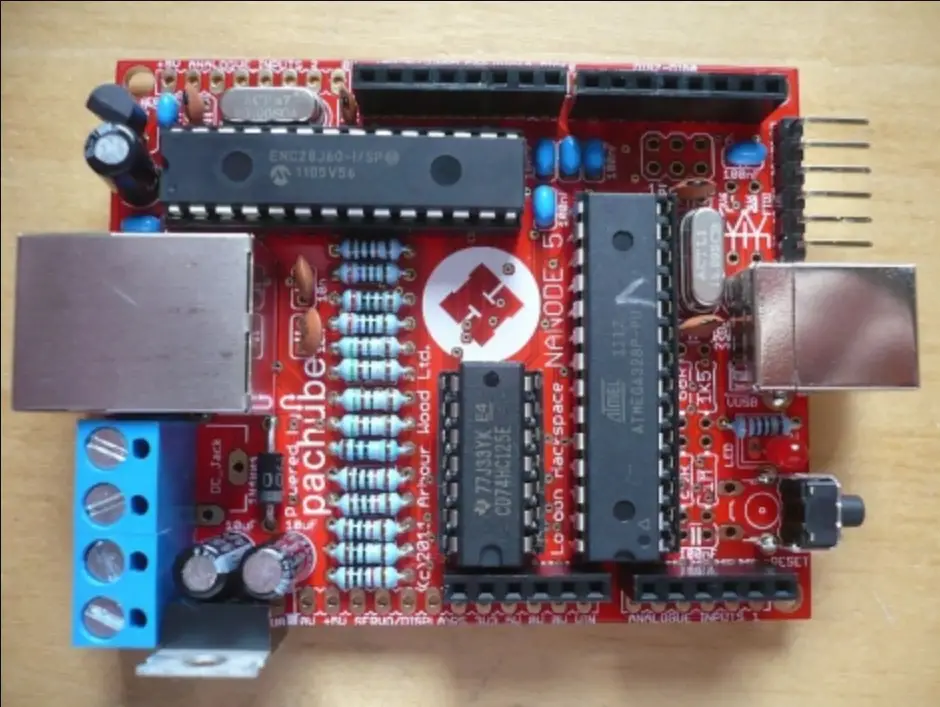 Another PCB variant, Nanode in red.
Another PCB variant, Nanode in red.
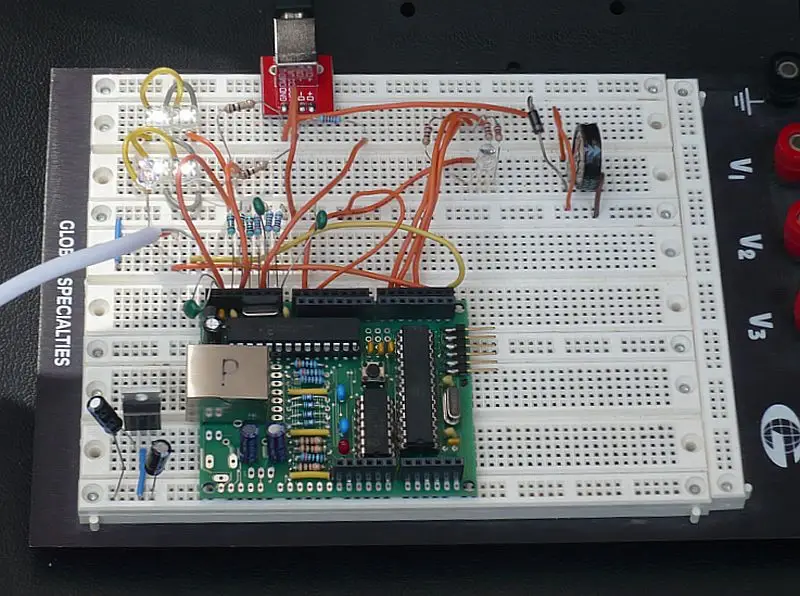 Nanode can slot straight into a breadboard for rapid prototyping / quick hacks!
Nanode can slot straight into a breadboard for rapid prototyping / quick hacks!
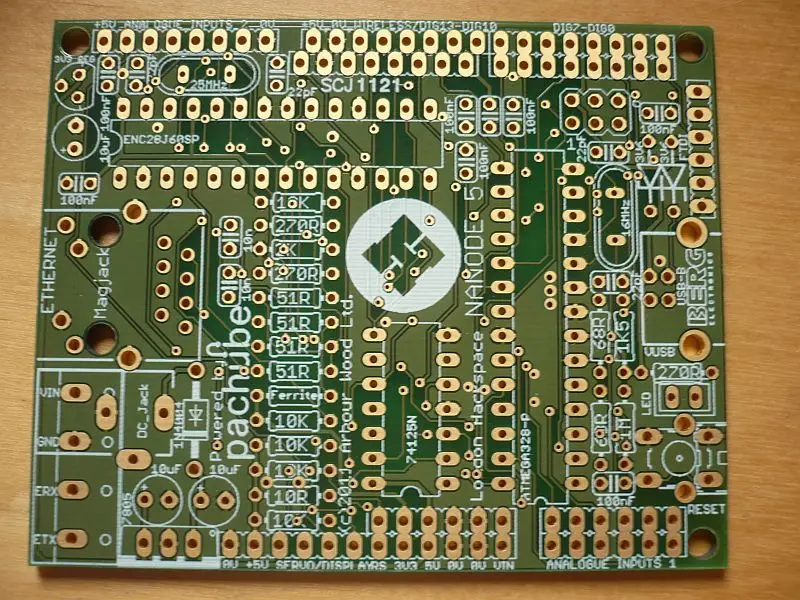 Latest Production Nanode pcb, topside.
Latest Production Nanode pcb, topside.
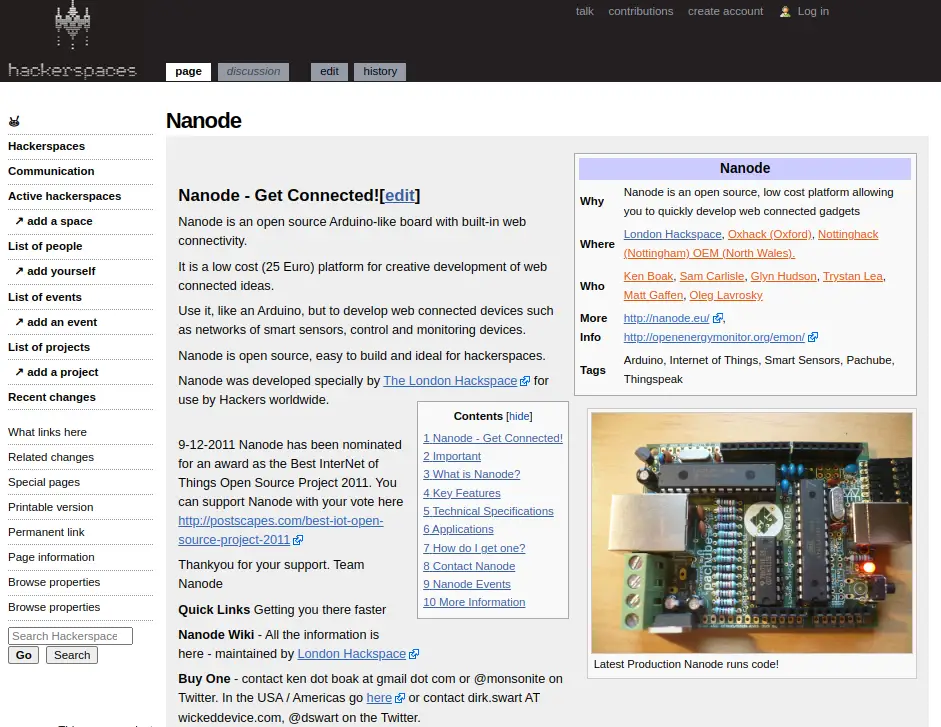 Nanode project on the international hackerspaces wiki.
Nanode project on the international hackerspaces wiki.
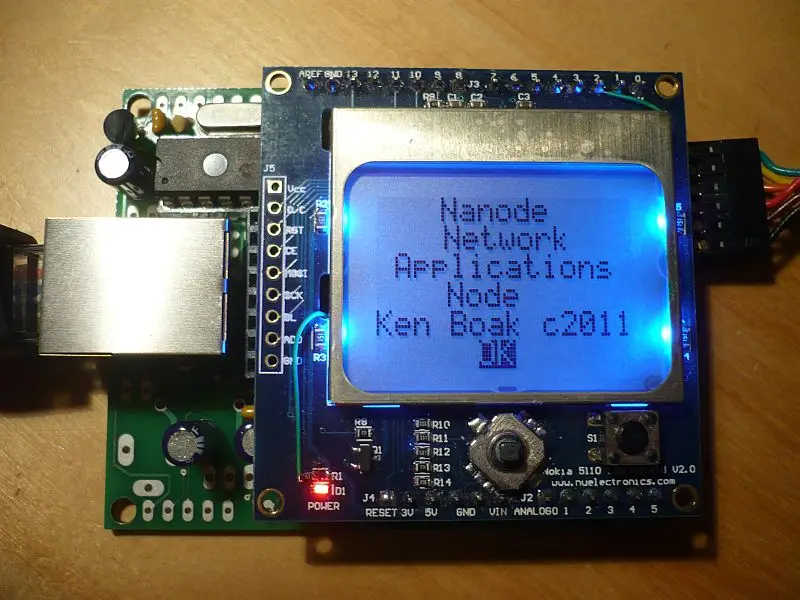 Nanode With Nokia 3310 LCD Shield
Nanode With Nokia 3310 LCD Shield